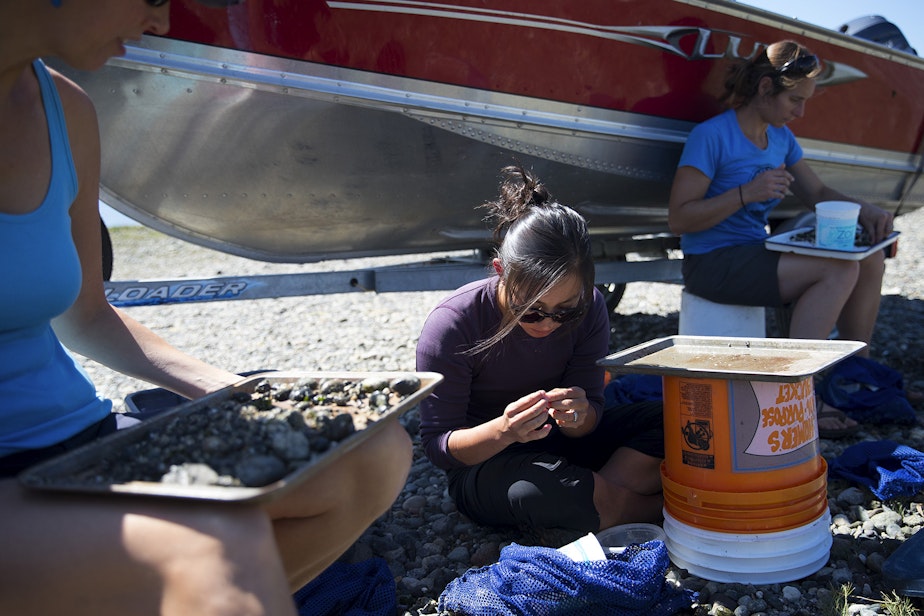A baby clam garden by the sea: A Northwest delicacy returns
John Cayou watched the rocky beach, waiting for a squirt of water to shoot up from the sand. A clam, revealing its spot.
Cayou dug in his pitchfork, and grabbed clams to put in his bucket.
He’s been harvesting clams since he was a kid. “I used to pick the clams for Mom,” he said. “She dug and I picked. And that’s the way we worked it.”
At 72, Cayou was perhaps the oldest of the dozen or so Swinomish clam diggers out on the beach on this sunny morning in late August. He said he remembers a time when there were a lot more clams.

“You’d take the bucket and the clam fork, and you would go out, and believe you me it wouldn’t take very long — maybe 10, 15 minutes max — you had a bucket,” he said. That's how many clams there were.
But native clams up and down the West Coast are not doing well anymore. The Swinomish Tribe is trying to solve that problem — for themselves and for other tribes and First Nations.
Clams were so important to the culture and food of the people of the Salish Sea that they dried them, strung them into necklaces, and ate them as a snack — or traded them inland. But, now, some clam beaches have tiny clams, or none at all.
Julie Barber, a shellfish biologist for the Swinomish Tribe said that “native littlenecks have declined so much throughout Washington’s inland waters that they’re really difficult to find now.”
Scientists are still trying to figure out all the reasons for that — but they’ve come up with a local stopgap solution: clam gardens.
“What a clam garden can do is provide a place for the tribe to continue their practice of harvesting clams for subsistence,” Barber explained.
A clam garden isn’t really a garden. It’s made of rocks.
“That rock wall creates a new rocky reef habitat that supports a whole different suite of marine plants and animals,” said Skye Augustine, an ecologist and a member of the Stz’uminus Nation, from the east coast of Vancouver Island.
She said it’s not like the kind of rock wall people build to protect their houses from the ocean.

For one thing, these walls aren’t solid: they’re permeable to water.
Also, “most of the time, for most of the year, you’re not actually going to be able to see the rock wall itself,” she said. “You can only actually see the rock wall at the very lowest tides of the year.”
The walls are designed so sand and bits of clam shell build up behind them.
Those bits of shell, plus the kelp growing in the clam garden, can make the water around them less acidic. Oceans are getting more acidic because of carbon in the atmosphere, and that’s bad for baby clams. These gardens can provide some buffered habitat.
And researchers hope clam gardens can also reduce beach erosion and reduce wave energy as sea levels rise.
This isn’t a new idea.
“Clam gardens have been around on the British Columbia, Alaskan, and Washington state coast for over 3,000 years,” Augustine said.
Most of those gardens have fallen into disuse.
Augustine runs a project that’s restoring two clam gardens in British Columbia.
The Swinomish’s would be the first revival of this tradition south of the border.
Right now, Barber, the biologist, and her colleagues are studying which reservation beaches have enough juvenile clams present that they’d be good options to place the clam garden. Then the decision will go to the tribe’s cultural office and the tribal council.
The Swinomish scientists are making their process public so that other tribes and First Nations can use their techniques to find good places to construct their own clam gardens.
Barber said, depending on how permitting goes, the garden could be built as soon as next summer.
At the annual Swinomish clam bake, more than a hundred tribal members gathered at long tables at a beach on the reservation, eating all kinds of shellfish.
“There’s the old Indian saying in this part of the world that when the tide is out the table is set,” said Larry Campbell, a Swinomish elder, “because the clams are in our tideland.”
The goal of the clam garden is to keep it that way.




